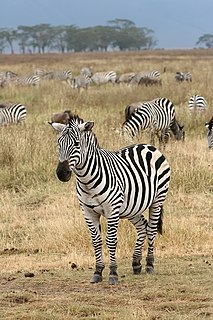 W
WThe chimpanzee, also known as the common chimpanzee, robust chimpanzee, or simply chimp, is a species of great ape native to the forest and savannah of tropical Africa. It has four confirmed subspecies and a fifth proposed subspecies. The chimpanzee and the closely related bonobo are classified in the genus Pan. Evidence from fossils and DNA sequencing shows that Pan is a sister taxon to the human lineage and is humans' closest living relative.
 W
WThe giraffe (Giraffa) is an African artiodactyl mammal, the tallest living terrestrial animal and the largest ruminant. It is traditionally considered to be one species, Giraffa camelopardalis, with nine subspecies. However, the existence of up to eight extant giraffe species has been described, based upon research into the mitochondrial and nuclear DNA, as well as morphological measurements of Giraffa. Seven other species are extinct, prehistoric species known from fossils.
 W
WGorillas are ground-dwelling, predominantly herbivorous apes that inhabit the forest of central Sub-Saharan Africa. The genus Gorilla is divided into two species: the eastern gorillas and the western gorillas, and either four or five subspecies. They are the largest living primates. The DNA of gorillas is highly similar to that of humans, from 95 to 99% depending on what is included, and they are the next closest living relatives to humans after the chimpanzees and bonobos.
 W
WThe hippopotamus, also called the hippo, common hippopotamus or river hippopotamus, is a large, mostly herbivorous, semiaquatic mammal and ungulate native to sub-Saharan Africa. It is one of only two extant species in the family Hippopotamidae, the other being the pygmy hippopotamus. The name comes from the ancient Greek for "river horse" (ἱπποπόταμος). After the elephant and rhinoceros, both of which are found in Africa, the hippopotamus is the third-largest type of land mammal and the heaviest extant artiodactyl. Despite their physical resemblance to pigs and other terrestrial even-toed ungulates, the closest living relatives of the Hippopotamidae are cetaceans, from which they diverged about 55 million years ago.
 W
WThe Royal python, also called the ball python, is a python species native to West and Central Africa, where it lives in grasslands and shrublands. It is listed as Least Concern on the IUCN Red List because of its wide distribution. It is threatened by hunting for its meat and for the international pet trade. This nonvenomous constrictor is the smallest of the African pythons, growing to a maximum length of 182 cm (72 in). The name "ball python" refers to its tendency to curl into a ball when stressed or frightened.
 W
WThe African rock python is a species of large constrictor snake in the family Pythonidae. The species is native to sub-Saharan Africa. It is one of 11 living species in the genus Python. It has two subspecies. One subspecies is found in Central and Western Africa, and the other subspecies is found in Southern Africa.
 W
WZebras are African equines with distinctive black-and-white striped coats. There are three extant species: the Grévy's zebra, plains zebra and the mountain zebra. Zebras share the genus Equus with horses and asses, the three groups being the only living members of the family Equidae. Zebra stripes come in different patterns, unique to each individual. Several theories have been proposed for the function of these stripes, with most evidence supporting them as a form of protection from biting flies. Zebras inhabit eastern and southern Africa and can be found in a variety of habitats such as savannahs, grasslands, woodlands, shrublands and mountainous areas.